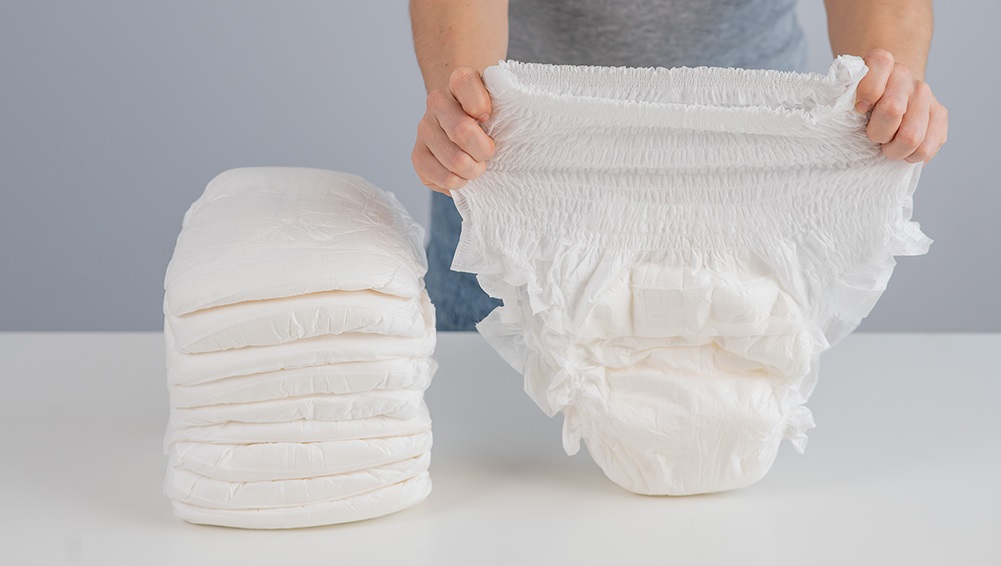
Summary
Urinary incontinence is common but manageable with the right strategies and products. Understanding the types, like stress, urge, mixed, and overflow incontinence, helps choose the best approach. Key tips include setting a bathroom routine, using absorbent products, wearing comfortable clothes, staying hydrated, and doing pelvic exercises. There are various products, like pads, briefs, and bed protectors, to meet different needs. Lifestyle changes, such as dietary adjustments and regular exercise, can help control incontinence. Caregivers can improve care by respecting privacy and organizing supplies. If symptoms worsen, seeking medical advice is important for better management. This blog provides general information and is not a replacement for professional medical advice. Consult your doctor for personalized guidance and recommendations tailored to your health.
Tips for Long-Term Incontinence Management
Urinary incontinence, characterized by the loss of bladder control, is a common health condition that affects millions of adults1 every year. Whether you experience occasional leaks or face chronic incontinence, there are strategies for maintaining dignity and practical solutions to managing this condition. Understanding the underlying causes, exploring comfort-focused products, and adopting long-term management techniques can greatly improve your quality of life. This blog provides general information about managing adult incontinence and is not intended to replace professional medical advice. Always consult your doctor for personalized guidance and recommendations regarding your health.
Understanding Adult Incontinence
Urinary incontinence comes in several forms, each with unique causes and symptoms. Understanding the different types of urinary incontinence is key to identifying your specific condition. By recognizing the underlying causes of bladder leakage, you can better manage symptoms and explore the most effective treatment options tailored to your needs. These types include:
- Stress incontinence occurs when physical activities like coughing, sneezing, laughing, or lifting put pressure on the bladder, causing urine leaks. It’s not related to emotional stress but to physical strain on the bladder. Leakage often involves small amounts of urine.
- Urge incontinence involves a sudden, overwhelming need to urinate, followed by involuntary urine loss. It can cause frequent urination, including at night. Known as an overactive bladder, this condition triggers a strong urge to urinate even when the bladder isn’t full, sometimes leading to accidents before reaching the bathroom. Urge incontinence can be triggered by a minor issue, like an infection, or a more serious condition, such as diabetes.
- Mixed incontinence takes place when you experience symptoms of both stress and urge incontinence. This often involves leaking urine from physical activities like coughing or sneezing, along with intense urges to urinate.2
- Overflow incontinence happens when the bladder doesn't empty fully, leading to frequent dribbling of urine. This can result from blockages or an underactive bladder muscle and can occur with or without the sensation of needing to urinate.
Product Solutions for Incontinence Management
Managing incontinence effectively begins with selecting the right products for your needs. With various options available, the best choice depends on your level of leakage and personal preferences. Some products are designed for light leaks, while others offer extra absorbency and extend wear-time. Here are some reliable solutions to ensure comfort, protection, and peace of mind:
Absorbent Pads and Liners
Incontinence pads, liners, and guards are designed for light to moderate incontinence. They fit easily into regular underwear and offer discreet protection. These insert products come in different sizes and absorbency levels to meet individual needs, offering a comfortable and convenient solution for managing incontinence.
Light incontinence pads and liners are absorbent and great for occasional leaks. Insert pads are slim, lightweight, and easy to use, fitting seamlessly into underwear without adding bulk. Individuals with an active lifestyle prefer flexible, moderate absorbency liners for managing occasional leaks or dribbles.
Guard pads are specifically designed for the male body with light incontinence levels and come in different sizes and styles to accommodate the needs of men. They discreetly protect the skin and prevent chaffing.
Adult Briefs and Pull-Up Diapers
Adult briefs and pull-up diapers are essential for managing moderate to severe incontinence, providing comfort and discretion so users can confidently go about their day. When choosing a specific product, it's important to consider factors such as absorbency, fit, waist size, and gender.
Pull-up diapers provide a comfortable, underwear-like fit with a soft, breathable fabric. They offer reliable absorbency and are easy to use, making them ideal for active adults. With no fasteners or tabs, absorbent pull-up diapers for incontinence feature elastic waistbands and leg openings for secure protection and can be pulled up and down like regular underwear.
Diapers with tabs are for severe incontinence and are ideal for managing moderate to heavier urinary leakage. Designed for those with limited mobility, these adult briefs have tab closures and can be changed easily while sitting or lying down. They feature high absorbency for day and night comfort, leak guards to prevent spills, and anti-odor technology for freshness, offering maximum protection.3


Bed Protectors
Bed protection products are ideal for managing nighttime incontinence, by protecting mattresses and bedding with a waterproof barrier. Available in reusable or disposable options, they make cleanup simple and help you sleep worry-free.
Absorbent underpads protect furniture and bedding from leaks. Disposable options have a high absorbency technology and discreet odor control features. They are created for easy placement and quick cleanup, which is helpful for caregivers and individuals managing bedtime incontinence. Reusable options provide a more economical solution to incontinence management. Made with ultra-absorbent materials, washable underpads are easy to use and clean.
For consistent protection against leaks, consider waterproof mattress pads. This will safeguard your mattress from incontinence leaks if an underpad doesn’t stay in place. It also helps protect against unwanted spills.
Practical Tips for Daily Management
Managing incontinence daily can be challenging, but with the right strategies and products, it’s possible to maintain comfort and confidence. From establishing a bathroom schedule to choosing the right products and clothing, there are practical ways to reduce accidents, protect your skin, and stay comfortable throughout the day. Here are some helpful tips for managing incontinence in everyday life.
- Establish a Bathroom Routine: Schedule bathroom breaks every two to three hours throughout the day, even if you don’t feel the urge to go. This helps maintain regular bladder habits, reduces accidents, and prevents leaks by making sure your bladder is emptied on a consistent schedule. Going before activities, leaving home, or bedtime can help prevent sudden urges and accidents.
- Use the Right Products: Choose activity-based incontinence products tailored to your level of leakage and daily activities. Whether it's liner pads for users with active lifestyles, breathable pull-up briefs for discretion, or disposable underpads for easy cleanup, selecting the right product keeps you comfortable and dry while managing leakage effectively.4
- Wear Comfortable Clothing: Wear loose-fitting clothing around the waist and lower abdomen to prevent pressure on the bladder and reduce incontinence symptoms. Opt for easy-change clothing that is simple to remove for quick diaper changes. Loose-fitting clothes with elastic waistbands can make it easier to change incontinence products when needed.
- Stay Hydrated: Drinking enough water helps prevent dehydration, which can irritate the bladder and worsen incontinence. Aim for 40–60 ounces daily, as excessive and insufficient fluid intake can aggravate symptoms. Keeping a regular fluid intake schedule can help retrain your bladder. Be mindful of how much you drink, especially before bed, to minimize nighttime accidents.5
- Protect Skin Health: Use moisture barrier creams and gentle wipes to keep skin clean and protected from irritation or rashes. Proper skin care for incontinence patients is crucial to keeping the skin healthy and includes regular moisturizing and timely changes of incontinence products.
Lifestyle Adjustments
Managing urinary incontinence effectively can often require lifestyle changes. These include implementing dietary changes for incontinence management and incorporating specific exercises for bladder control. Here are some helpful lifestyle adjustments that can help with urinary symptoms:
- Dietary Changes: Certain foods and drinks can irritate the bladder and exacerbate incontinence symptoms. Bladder irritants include alcohol, caffeine, and acidic foods. A balanced diet with fiber can also help prevent constipation, which can make incontinence worse.6
- Exercise: Regular physical activity is important for your overall health. If you're worried about not having a bathroom nearby during an activity, choose a location with accessible restrooms, like a shopping mall, community park, or local gym. Pelvic floor strengthening exercises called Kegels can help strengthen the muscles that control urination. Kegel exercises focus on contracting and relaxing the muscles that regulate urine flow, enhancing bladder control, reducing leakage, and improving overall urinary health.


Tips for Caregivers
Urinary incontinence can be physically uncomfortable and difficult to discuss. Caregivers can provide incontinence care with dignity by respecting privacy and involving the individual in decisions about their care. Caregiver tips for managing incontinence include:
- Respect Privacy: Always knock before entering a room, and close doors or curtains when assisting with personal care tasks to provide privacy during incontinence care. Whenever possible, involve the person you're helping in their care decisions. Whether choosing the right incontinence product or adjusting routines, allowing them to have input helps maintain their dignity and sense of control.
- Organize Incontinence Supplies: Keep incontinence products and other caregiving supplies well-organized and easily accessible. Having everything ready in advance reduces stress and helps to assist efficiently without unnecessary interruptions. Disposable gloves, flushable wipes, and odor-neutralizing spray help make cleanup easier for the caregiver if an accident happens.
- Use Discreet Products: Choose incontinence products that are tactful, comfortable, and effective, encouraging the person to feel as normal and independent as possible. Products designed for discreetness allow them to maintain confidence in their daily lives.
When to Seek Medical Advice
Occasional urine leakage may not always require medical attention, however, certain signs of worsening incontinence may indicate the need for professional medical evaluation for bladder issues. Seeking medical advice can help identify underlying causes, provide appropriate management strategies, and recommend treatment options for chronic incontinence. Here are some signs that indicate when to consult a doctor:
- Worsening Symptoms: If leakage or sudden urges become more frequent or severe
- Sudden Changes: Loss of bladder control, pain, or cloudy or bloody urine7
- Daily Disruptions: Urinating eight or more times a day, affecting sleep, work, or social activities
- Other Symptoms: Trouble emptying the bladder or having a weak urine stream
Conclusion
Managing urinary incontinence involves lifestyle changes, proper care, and using the right products. Sticking to a bathroom schedule, using absorbent products, staying hydrated, and doing pelvic floor exercises can help with long-term incontinence management. Choosing personalized incontinence products, from discreet pads to protective wear, provides comfort and confidence. Explore incontinence product ranges to find the best fit for your needs and improve your quality of life today.
Footnotes
- 1 "Urinary Incontinence in Women." Johns Hopkins Medicine. https://www.hopkinsmedicine.org/health/conditions-and-diseases/urinary-incontinence/urinary-incontinence-in-women. Accessed 28 January 2025.
- 2 "Urinary incontinence." Mayo Clinic, February 9, 2023, https://www.mayoclinic.org/diseases-conditions/urinary-incontinence/symptoms-causes/syc-20352808.
- 3 "Understanding The Differences In Incontinence Products." National Association for Continence. https://nafc.org/bhealth-blog/understanding-the-differences-in-incontinence-products/. Accessed 29 January 2025.
- 4 "Urinary Incontinence." Cleveland Clinic, October 23, 2020, https://my.clevelandclinic.org/health/diseases/17596-urinary-incontinence.
- 5 "6 Helpful Tips for Managing Urinary Incontinence." Mayo Clinic Health System, February 23, 2022, https://www.mayoclinichealthsystem.org/hometown-health/speaking-of-health/6-helpful-tips-for-managing-urinary-retention-and-incontinence.
- 6 "Treatments for Bladder Control Problems." National Institute of Diabetes and Digestive and Kidney Diseases, July 2021, https://www.niddk.nih.gov/health-information/urologic-diseases/bladder-control-problems/treatment.
- 7 "Urinary Incontinence in Older Adults." National Institute on Aging, January 24, 2022, https://www.nia.nih.gov/health/bladder-health-and-incontinence/urinary-incontinence-older-adults.
